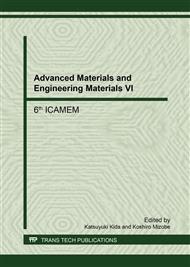p.254
p.259
p.264
p.269
p.275
p.280
p.284
p.288
p.295
A Study of the Interaction between Abrasive Waterjet and Target by CFD and FEM Method
Abstract:
The interaction between abrasive waterjet and target is studied by computational fluid dynamics (CFD) and finite element method (FEM). The flow field inside and outside abrasive waterjet (AWJ) nozzle is obtained by CFD software. Then the pressure distribution of the fluid on the target is plotted, which is in well agreement with the force distribution of the AWJ impacting on the target and leads to the material deformation. The interaction between the AWJ and target and the fluid-solid coupling is happened. The cloud figure of the target’s deformation and stress are obtained by FEM software. The AWJ parameters such as the flow velocity, off-set and abrasive volume factor have a great effect on the material deformation and the stress distribution. The study results provide a new method to study abrasive water jet machine mechanism and help to optimize process parameters.
Info:
Periodical:
Pages:
275-279
Citation:
Online since:
August 2017
Authors:
Price:
Сopyright:
© 2017 Trans Tech Publications Ltd. All Rights Reserved
Share:
Citation:


